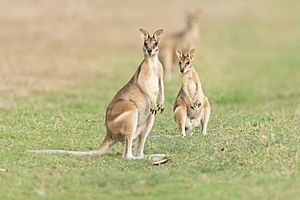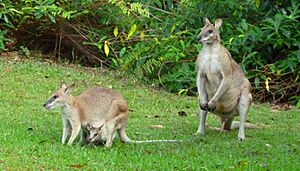Agile wallaby facts for kids
Quick facts for kids Agile wallaby |
|
|---|---|
 |
|
| Conservation status | |
| Scientific classification | |
| Genus: |
Macropus
|
| Species: |
agilis
|
 |
|
| Agile wallaby range | |
The agile wallaby (Macropus agilis), also called the sandy wallaby, is a type of wallaby. You can find them in northern Australia and New Guinea. They are the most common wallaby in northern Australia. Agile wallabies have sandy-colored fur that is lighter on their belly. They sometimes live alone, but can also be found in groups. They mostly eat grasses and other plants. Good news! The agile wallaby is not considered in danger of disappearing.
Indigenous people in Australia have special names for the agile wallaby. For example, the Kunwinjku people in western Arnhem Land call this animal konabalar. They call the male warradjurk and the female malbe. A baby wallaby, called a joey, is known as njip by the Kunwinjku. The Bininj Kunwok dictionary lists other names, like warradjangkal for a male and merlbbe for a female.
Contents
Meet the Agile Wallaby: What They Look Like
Male agile wallabies are much bigger than females. Males can be up to 85 cm (33 inches) long and weigh from 16 to 27 kg (35 to 60 pounds). Females are smaller, growing to about 72 cm (28 inches) long and weighing 9 to 15 kg (20 to 33 pounds). Both males and females have long, flexible tails. Their tails can be twice as long as their head and body!
Agile wallabies have fairly large ears with black edges. The tip of their tail is also black. Their fur is sandy brown on their backs and whitish underneath. They have a dark stripe between their ears. You can also spot a pale stripe on each cheek and another light streak across their thighs.
Where Do Agile Wallabies Live?
The agile wallaby lives in northern Australia, Papua New Guinea, and the Indonesian province of Papua. They are the most common wallaby in many parts of northern Australia. You can find them often in northern Australia and along the eastern coast of Queensland. There are also smaller groups in southeastern Queensland.
Agile wallabies like dry, open woodlands, grassy areas, and sand dunes. They are often found near rivers and waterholes called billabongs. If there isn't enough grass, they might eat shrubs. Sometimes, they even go into farms, like sugar cane fields, to find food.
How Agile Wallabies Behave
Agile wallabies usually like to be alone. However, they sometimes gather in groups when they are eating in open fields. This helps them stay safe by watching out for predators. They mostly eat at night, munching on grasses, legumes, and other plants. But they might also look for food during the day, especially when it's wet.
In the dry season, when food is harder to find, they travel further. Their diet changes to include flowers, fruits, twigs, fallen leaves, roots, and bark. In some parks, they have been seen pulling up small palm trees to eat their roots and stems. They also eat the hard seeds of these palms. They even eat seeds that have passed through birds! Sometimes, they dig holes in dry creeks to find water. This helps them avoid dangerous animals like the saltwater crocodile (Crocodylus porosus) that live near rivers.
Agile wallabies can have babies any time of the year. The female is ready to have another baby soon after giving birth. Male wallabies sometimes "play-fight" by leaping and lashing their tails. After a short time together, they mate. Then, something cool happens: the baby inside the mother pauses its growth for a while. This is called embryonic diapause. The baby then starts growing again. It takes about 30 days for the baby to be born. The tiny joey then crawls into its mother's pouch. It stays there for 7 to 8 months and drinks milk until it's about 11 months old.
Agile Wallaby Status: Are They Safe?
The agile wallaby lives in a large area and is very common in many places. They don't face many big threats. In New Guinea, people sometimes hunt them for food. In Australia, farmers might kill them if they become a pest. They live in many protected areas in Australia, but not as much in New Guinea.
Overall, the number of agile wallabies might be slowly going down. But there are still many of them. Because of this, the IUCN says the agile wallaby is of least concern. This means they are not in immediate danger of disappearing. In Western Province, Papua New Guinea, local people hunt agile wallabies using fire to guide them.
Images for kids
See also
 In Spanish: Ualabí ágil para niños
In Spanish: Ualabí ágil para niños




